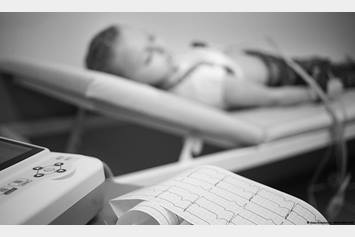Bicuspid Aortic Valve
A bicuspid aortic valve is a heart problem present at birth. The aortic valve has two cusps instead of three.
What Is Bicuspid Aortic Valve?
Bicuspid aortic valve disease (BAV) is an irregularity in the heart where there are only two leaflets on a valve, instead of the normal three. The third leaflet does not develop properly, with two leaflets fusing together (being “stuck” together). The bicuspid aortic valve opens and closes abnormally, and can result in leaking of the valve.
The aorta is the major artery that supplies the body with blood high in oxygen that is pumped out of the heart. The aortic valve is a one-way valve (doorway) between the heart and the aorta. Normally, the aortic valve has three small flaps or leaflets that open widely and close tightly to regulate blood flow. The valve allows blood to flow from the left ventricle (pumping chamber) to the aorta and prevents blood from flowing backward.
Bicuspid aortic valve disease is an irregularity in the heart where there are only two leaflets on a valve, instead of the normal three. The third leaflet does not develop properly, with two leaflets fusing together (being “stuck” together). The bicuspid aortic valve opens and closes abnormally, and can result in leaking of the valve.
The fusion (sticking together) of the valve leaflets causes abnormal valve opening and closing. If the valve does not close completely, blood can leak into the heart. The valve may also become stiff due to calcium deposits on the leaflets over time.
Bicuspid aortic valves may also be associated with:
- Enlargement of aortic root (first section of the aorta)
- Enlargement of left ventricle (pumping chamber)
Although bicuspid aortic valves are present at birth, it may not be diagnosed until adulthood because the abnormal valve can function for many years without symptoms. Treatments for BAV will vary based on the severity of the condition. There are several diagnosis methods, and measures that can be taken to help maintain a heart healthy lifestyle.
What Are the Signs and Symptoms of Bicuspid Aortic Valve?
Symptoms that can be caused by having a bicuspid aortic valve include:
- Shortness of breath, especially with exercise or activity
- Chest pain
- Palpitations (extra heart beats)
- Fatigue/tiredness
What Causes Bicuspid Aortic Valve?
Bicuspid aortic valve disease (BAV) is caused when the third leaflet of the aortic valve does not develop properly. Two leaflets are stuck together causing the value to open and close abnormally.
What Are the Risk Factors?
Despite surgery to repair aortic valve narrowing and/or aortic enlargement, some patients can develop long term complications, including:
- Left ventricular hypertrophy: Narrowing of the aortic valve forces the left ventricle (left pumping chamber) to work harder to pump blood through this stiff/narrow area. Over time, the muscle of the left ventricle may become thick, bulky, and not pump as well. This may lead to a weak heart muscle and irregular heartbeats.
- Aortic aneurysm: The enlargement of the aorta can cause a bulging area where the walls are thin and over-stretched. Such changes may result in rupture or tearing of the aorta and is life-threatening.
- Subacute bacterial endocarditis (SBE): Rough/turbulent blood flow inside the heart may put patients with a bicuspid aortic valve at risk to develop an infection in the heart. If bacteria enter the blood stream it can attach to the valve and cause damage.
- Blood pressure control: High/elevated blood pressure should be avoided to prevent stress on the thin walls of the enlarged aorta. Medications may be needed to control blood pressure.
How Is Bicuspid Aortic Valve Diagnosed?
A bicuspid aortic valve can be diagnosed by:
- Echocardiogram (ultrasound pictures of the heart)
- Cardiac MRI (magnetic resonance imaging)
- Cardiac CT (computerized tomography)
- Electrocardiogram (EKG)
How Is Bicuspid Aortic Valve Treated?
Several treatment options are available for patients with a bicuspid aortic valve.
Treatment is dependent on how well the valve is working and if the aortic root is enlarged. If the valve is functioning relatively normally without major narrowing/constriction or leaking and the first section of the aorta (aortic root) is not too large, the condition may just be monitored by your cardiologist.
If symptoms increase, the valve function worsens or the first part of the aorta (aortic root) grows larger, surgery may be necessary to repair the problem. The types of surgery and catheter procedures used to correct bicuspid aortic valve are outlined below.
Balloon Aortic Valvuloplasty Via A Heart Catheterization
A heart catheter is a hollow plastic tube about the size of a piece of thin spaghetti, which can be seen on a special x-ray camera that is used in the catheterization lab. The doctor guides the catheter through the big blood vessels to the heart in order to collect blood and measure pressure. A special dye/contrast is used to take the picture of the heart, which is recorded and saved.
Routine heart catheterization evaluates three major things:
- The amount of oxygen in the blood and in each chamber of the heart
- The blood pressure in each chamber of the heart
- Pictures are taken of the heart chambers
From these, the cardiologist can determine what needs to be done next.
Transcatheter balloon valvuloplasty that happens during a heart catheterization involves the insertion of a catheter with an uninflated balloon into the narrowed/constricted (stenotic) valve opening. The balloon is then inflated, then deflated, and removed. This procedure is used to relieve the narrowing/constriction of aortic valve.
Aortic Valve Repair or Replacement Without Aortic Root Enlargement
- Valve Repair: The valve is tightened with stitched to reduce leaking (Figure A)
- Mechanical Valve Replacement: Bicuspid valve is removed and is replaced with a mechanical valve (Figure B)
- Tissue Valve (Bioprosthetic) Replacement: Bicuspid valve is removed and replaced with cadaver or animal tissue valve (Figure C)
- Bicuspid Aortic Valve: Intraoperative view of native bicuspid aortic valve prior to surgery (Figure D)
- Ross Procedure: the patient’s own pulmonary valve is removed and used to replace the bicuspid aortic valve, a tissue valve used to replace pulmonary valve (Figure E)
Aortic Valve Disease With Aortic Root Enlargement
- David Procedure or Valve-Sparing Aortic Root Replacement: Ascending aorta is removed above valve, a vascular graft replaces the aorta, coronary arteries are attached to graft (Figure A)
- Aortic Root and Valve Replacement: Ascending aorta and valve are removed, a vascular graft with an artificial (mechanical or tissue) valve is placed, coronary arteries are attached to graft (Figure B)
Can Bicuspid Aortic Valve Be Prevented or Cured?
Early identification and treatment of long-term complications are essential in keeping you healthy. This can be achieved by:
- Routine clinic follow-up: Physical examination may reveal increased valve problems and heart failure.
- Cardiac imaging studies: Echocardiogram, cardiac MRI or cardiac CT may be used to identify aortic aneurysm, aortic root enlargement, and to evaluate the left ventricle.
- Be aware of cardiac symptoms: Seek medical attention for chest or back pain, racing or skipping heart beats, shortness of breath, or persistent unexplained fevers.
Promote a Heart Healthy Lifestyle
- Avoid all tobacco products
- Take medications as they are prescribed (including antibiotics for dental procedures, tattoos, & piercings if indicated for your heart defect)
- Blood pressure and weight control
- Control of blood fats (cholesterol, triglycerides)
- Eat a healthy diet (low-sodium, low-fat)
- Regular aerobic exercise for at least 30 minutes most days of the week
- Avoid isometric exercises (heavy weight lifting, chin ups, push ups), grunting or straining activities that cause added strain to the heart
- Avoid dietary or medication sources of stimulants
- If you are female, it is important to plan pregnancy with your cardiologist to ensure optimal cardiac status, prior to becoming pregnant



